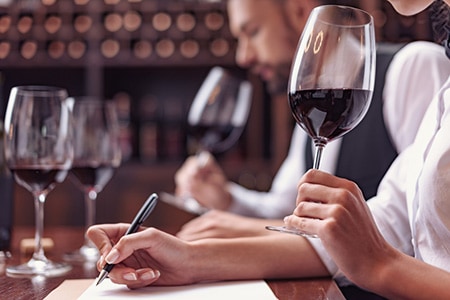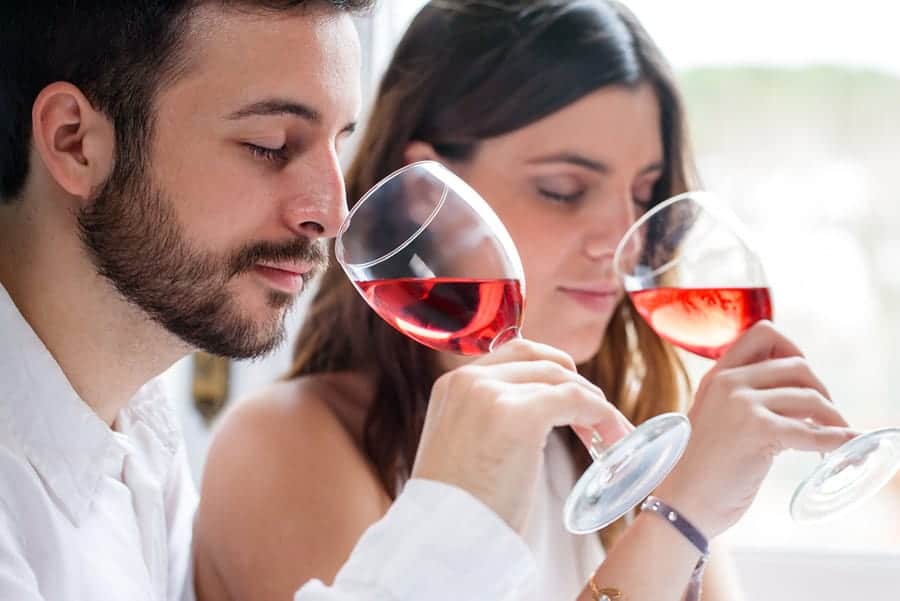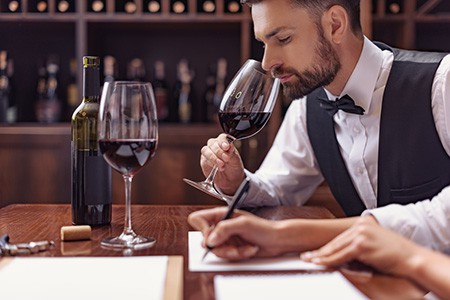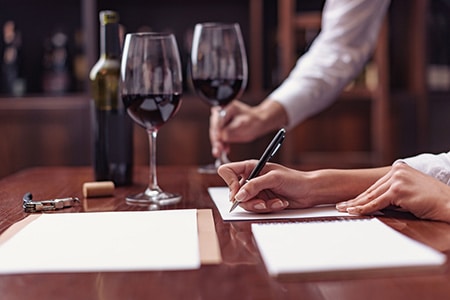How to Take Better Wine Tasting Notes [Plus Free Template]

The way you take tasting notes for wine is ultimately a personal thing. It's your record of your experience, your memories.
Therefore, there isn't really a right or a wrong way to do it.
However, when it comes to comparing notes with friends or online it helps to have common frames of reference.
That's what I'm going to explain in this guide.
This is how I take wine tasting notes! Discover the steps I take and the way I assess each wine.
Plus there's a free printable wine tasting notes template! Jump straight to it here.
Do I Really Need to Take Wine Tasting Notes?
If you want a reliable way of remembering wines and comparing them with other wines then yes you do.
There's just such a huge variety of wines with so many variables. Vintage, manufacturer, varietal, and region are just a few distinguishable features.
But that's not the only reason we take wine tasting notes.
Here are a the main reasons to put pencil to paper or finger to smartphone and take some notes when tasting wine.
How to Take Useful Wine Tasting Notes
It's useful to use a standard wine tasting notes template for each event.
Whether it be reds, whites, sparkling, or fortified it doesn't really matter. There will be certain differences for each but that's okay.
What I've included below is a set of key areas to cover. Think of this as a wine tasting checklist.
These ideas serve as a set of great beginner's wine tasting notes that you can personalize and develop as you become more experienced.
We use the same wine descriptors and structure that we use in our wine notes template that's found in the next section.
- 1Appearance
- 2Aroma
- 3Taste
- 4Structure
- 5Finish
- 6Overall Impression
- 7Wine Details
1. Appearance
The very first thing to do is to take a moment to assess how the wine looks.
What color is the wine? How intense is the color?
Words like 'red' are fine but it's better to try and use words that describe the intensity and shade more accurately.
For example, rosé wines range from a very pale salmon to almost a neon pink and white wines can range from a pale lemon to a bright gold.
Consider how something like a deep ruby Shiraz looks in comparison to a pale ruby Pinot Noir.
How is the clarity?
The clarity isn't such an important factor these days due to modern winemaking techniques. It's rarely anything other than 'clear' unless a wine is unfiltered, particularly old, or there's an issue with it.
What is the viscosity like?
Give your wine a swirl and coat the glass. The viscosity or 'legs' can be observed as the drips that coat the sides of your glass (or not).
A viscous wine with 'great legs' is said to be one that coats the glass with slowly falling drips or 'stripes'.
A common misconception is that this indicates a good wine. Both good and bad wines can have 'great legs.
The viscosity of a wine can reveal to us two things:
- 1The sugar content - the concentration of sugar influences the viscosity. The sweeter a wine is the more pronounced the legs.
- 2The alcohol content - the higher the ABV the more viscous a wine is.
It should be noted that a viscous wine may only meet one of these criteria. For example, Shiraz/Syrah wine is a dry wine but tends to be viscous because of its high ABV.

2. Aroma
Swirl your wine again and take a sniff.
Wine aromas are split into three categories depending on how they were produced.
- 1Primary Aromas - these are usually the easiest to detect and most notable smells. They are produced by the grape varieties used. Red wines can have aromas of things like dark berries, cherries, and jam. Examples of aromas of white wines include citrus, flowers, mango, and green apple. Spices, pepper, herbs, and licorice are also common primary aromas.
- 2Secondary Aromas - these aromas are a result of winemaking processes. The ways in which wine is aged and the fermentation techniques involved are two methods of imparting certain aromas (and flavors) into a wine. For example, malolactic fermentation gives some Chardonnay a buttery note. Examples of secondary aromas include notes like vanilla, cloves, toast, and coconut.
- 3Tertiary Aromas - these more complex aromas only develop once a wine is aged in the bottle. Notes like mushroom, tobacco, dried fruits, and more complex spices can develop.

3. Taste
The flavor of a wine is very closely linked to its aroma. This is the category in wine tasting notes that we tend to pay most attention to.
But the truth is, our taste buds are quite limited. We can identify just five basic tastes. These are:
Wine tasting is a skill we need to develop. Both our appreciation of specific flavors and the vocabulary needed to describe them accurately.
In the beginning it can be easy to pick out the dark berry notes in a bold red but we need to be more specific. If not, we'll just end up with really similar notes across the board.
Is it fresh strawberries or maybe a blueberry jam? Is it ground black pepper or white pepper?
But, don't worry if you find this difficult. It will come in time as you get more experienced after more wine tastings. Actually, a great way to practice is by doing comparative wine tastings.
Here are some examples of general flavors and the more specific sub-categories that we should be using:
This list is by no means exhaustive but it serves as a good starting point. You should break down other general categories like 'spices', 'flowers', 'earthy', and 'minerals' whenever possible too.
You should also try and use more adjectives to describe the flavors.
For example, descriptions like, 'baked green apple', and 'ripe orange' are much more evocative
4. Structure
The structure of wine is closely linked to the flavor and you could easily put these together under the same heading.
For me, the 'structure' of a wine involves the following:
5. Finish
How long does the taste linger in your mouth? A long and pleasant finish is usually an indication of good wine but it's not always desirable when pairing with food. We describe the length of finish as long, medium or short.
We also describe the finish with the last flavors and sensations that linger in your mouth.
A 'hot' or 'harsh' finish would be one that produces an alcohol burn sensation. This is the sign of an unbalanced wine.
We can also use adjectives like bitter, spicy, peppery, and savory.
6. Overall Impression
This doesn't need to be a numerical score but it helps when ranking your wines and finding favorites. It also gives you an overall impression of the wine tasting 'at a glance'.
A simple one or two word summary works well too.

7. Wine Details
The wine details include the wine's full name, the producer, its region of origin, the grape varieties used, the alcohol percentage (ABV), and of course, the price.
You also want to record anything notable regarding the winemaking process.
Is it aged in steel vats or oak barrels? For how long is it aged? Is there anything remarkable about the vineyard?
But, don't get bogged down in detail here. You can add a lot of this information later. You want to allow yourself plenty of time to taste and judge the actual wine.
Recommended: How does a fun online wine quiz sound? I'll bet you can't get 100%!
Why Not Add the Details Before You Begin Tasting the Wine?
There's a good reason I added this as the last part of our wine tasting notes.
It's to do with reporting bias.
It's best to know as little as possible about something before you assess it.
We have all kinds of subconscious prejudices that can cloud our judgement. This is especially true with the price of wine. The value of something is often used as a clever marketing tool to convince us that something is of high quality. It's definitely not something we want to know before tasting a wine.
Certain wine regions also have considerable reputations and hold significant influence in the wine world.
For the most truly personal and unbiased assessment of wine it's best to know next to nothing about the wine before you get your hands on it.
Wine Tasting Notes Template [Free Printable PDF Download]
If you need a simple template for taking wine tasting notes, I think you'll find our printable wine tasting sheets really useful.
There's a beginner friendly version with some gentle pointers on what to look for at each step and also a more stripped down version for those that have done it all before.
How to Prepare For a Wine Tasting
Wine tasting can be affected by a variety of physiological factors. It's best to prepare for these or you may find that the same wine tastes differently to you on separate occasions.
Here are a few tips to get you primed for wine tasting!
1. Make sure you're not hungry. Although it's advisable not to swallow too much wine and to use a bucket, you'll still want to sample a few good wines. We've all heard the rule about not drinking on an empty stomach and it rings pretty true. A further reason to eat is because being hungry will cloud our judgement.
2. Give plenty of time for your palate to settle. Eating or drinking anything with a reasonably strong flavor will influence the taste of the wine (the same goes for smoking). Therefore, it's best not to eat (or drink anything like coffee) within an hour of tasting wine. You can help reset your palate by eating something neutral like bread or a cracker.
3. Give your taste buds a break. Your palate can become fatigued if it is tasked with tasting too many wines in any one session. This is a result of the mental exhaustion of concentrating for long periods and also the physical exhaustion of your palate which gets 'burnt out' by the alcohol and tannins. Regularly using palate cleansers can help but you ultimately need to take breaks.
4. Be open minded and also mindful of things that can cause bias. Go into your wine tasting with an open mind. Forget what you've read, what people might have told you about the winery, and also forget about how you've been treated by the staff. Your only focus is the wine in front of you. It deserves an unbiased appraisal, good or bad!
Related: Learn all about wine tasting etiquette in our guide on what's expected.
Wine Turtle Wine Tasting Tip
Preserve your palate for longer by tasting wines in order. A basic rule is to taste the more delicate white wines before tannic reds but there are other rules that are a great help too. Check them out in our guide to wine tasting order.
Tools You Can Use for Taking Wine Notes
Of course, the traditional pencil and paper method is absolutely fine. However, cataloging your notes can become difficult once your wine tastings add up.
Using your smartphone can help with this problem.
There are certain smartphone apps that allow to record and file your wine tasting notes. They take care of the organization storage problem that a pencil and paper creates.
My favorite apps for this are:
These apps all have the added bonus of allowing you to find local wine stores that stock the wines you are looking for.
